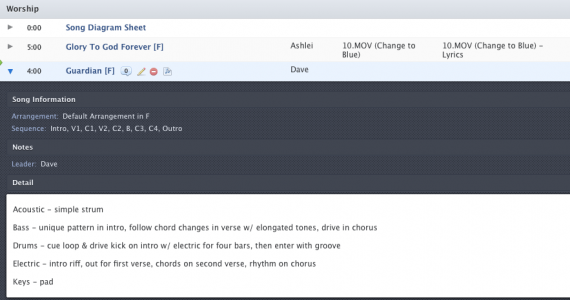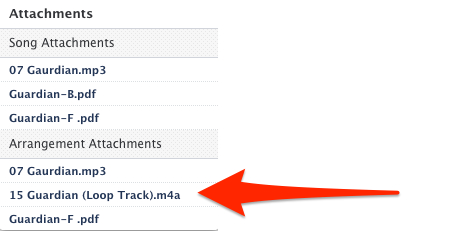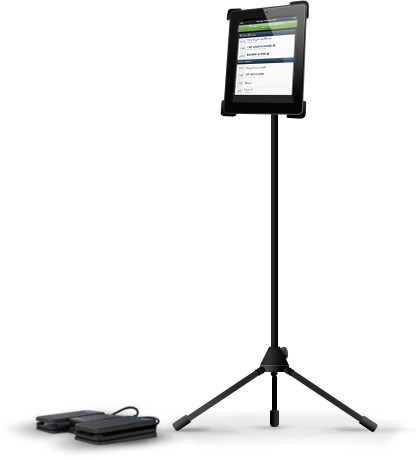One of the hallmarks of a great leader is communication.
If a leader doesn’t communicate a vision or keep followers in the loop as to what is coming next, team members will disengage. Even worse, they will come up with their own vision of what is going on.
That’s why I love Planning Center.

Planning Center doesn’t cast vision for me like a magical worship team vision robot (though that may be in the product pipeline), but it creates an infrastructure for it to happen. It also helps me guide my musicians, worship leaders, and singers to another level of excellence.
Because that is one of my goals as a worship pastor – to guide, mentor, and develop those I work with.
How Great Leaders Communicate
As I shared in my newsletter this week, great leaders communicate in 3 ways:
1. Clear – When you communicate, take the time to think through what you are going to say. Analyze it. Does it make sense? Is it easily digestible for your people? Don’t try and be too deep or clever. Just be clear.
2. Constant – Leaders must constantly communicate. Matter of fact, it should be one of your primary roles. Without it, people will set their own agenda.
3. Compelling – The goal of good communication is to inspire and motivate. Always ask this – “Am I moving my people to action?”
In this post, I want to outline 5 ways that we use Planning Center to keep us clear, constant, and compelling with our vision.
Here’s the main idea:
You can’t expect your team to be excellent if you don’t set them up for excellence.
Excellent teams are led by excellent leaders. I’m not just talking about talent. I’m talking about organization, planning, and vision.
5 Ways We Use Planning Center
Are you ready? Let’s dive in.
1. For Advanced Scheduling
What’s beautiful about Planning Center is team members can go into their profile calendar and select their “block-out” dates. These are dates they are out of town or busy and cannot be scheduled.
My goal with scheduling is to remain 3 months ahead at all times. This gives people enough time to check their schedules and plan.
A last minute leader is no leader at all. Because the nature of leading is giving people enough time to catch the vision and adjust their schedules to achieve it.
2. For Song Arrangements
It’s always frustrating to leave your team guessing. That’s why I provide basic arrangement notes for each song in the “Detail” section as well as provide a Song Diagram Chart for musicians. I upload this chart right into every Planning Center tech sheet.

I want to teach my musicians to listen to a song and chart their own part. This helps musicians show up extra prepared, which is good for everybody – good for the musician, good for the leader, good for the team, and good for the congregation.
Notice also how you can add the sequence of how you’re going to perform the song. Another great tool for a musician’s preparation.
3. For Listening to Music

I like for my musicians to listen and learn recorded arrangements. It teaches discipline, humility, and smart musicianship.
That’s not to say we’ll never change an arrangement. Or that we’ll never do original music. We do both.
But as a general rule, I make sure mp3’s (or youtube links) are uploaded into the arrangement section of each song, along with a chord chart of the proper key.
What’s fantastic about Planning Center is you can access the mp3’s and youtube links straight from your computer, iPhone, or iPad.
And if you still have some team members who are into CDs, they can download the mp3s and burn them. As a side note, you’ll want to make sure you have the CCLI Rehearse License to do this legally.
 4. For Loops
4. For Loops
We love to use loops for a bunch of songs we do.
Sometimes we create our own (btw, loops for our Allison Park Worship songs can be found HERE on the resources page), or we purchase them from multitracks.com, loop community, or from the artist directly.
I like to make these loops available in Planning Center, particularly for our drummers to practice with. I upload it just like the regular mp3 and there you have it!
Again, it’s about creating that context for musicians to rise to another level of excellence.
5. For Charts
 While we’ve introduced a new standard of music memorization at my church, there’s the occasional time where a chart is still needed at rehearsal.
While we’ve introduced a new standard of music memorization at my church, there’s the occasional time where a chart is still needed at rehearsal.
Rather than printing music, we simply use Planning Center Music Stand on an iPad.
For an extra $10 a month you can add this great feature which allows you to access the previously uploaded charts straight from you iPad and swipe through them easily. Or, you can use a foot pedal to “step” through your songlist.
Another great option for charts is OnSong, though I haven’t used this quite as much.
What About You?
I hope that was helpful to see how we use Planning Center.
Do you use Planning Center? If so, what are some other creative ways you are using it?
If you don’t use Planning Center, what are you using for scheduling and organizing your teams?
[ois skin=”Beyond Sunday 2″]
David,
Great post. I use Planning Center as well and my team absolutely loves it. We have different worship services going on every week and it helps me keep different worship teams/music straight. I’m curious to know what your standard of memorization is and how did you transition into that? Did your team respond well to it at first?
Brian, I started off by casting vision for it. I said “within the next few weeks” we’ll transition to this. I explained my reasoning. Getting our songlists up way in advance helps. The only pushback I received was from a couple of the older guys but they’re doing a great job now, utilizing the song diagram charts and coming ready.
I love Planning Center. It doesn’t take away the administrative side of worship ministry but it definitely simplifies and streamlines it.
I love that everything I purchase or download on Praisecharts can be linked with a touch of a button now instead of the long process of scanning or copying and having a download code.
I also transpose the mp3’s frequently especially for newer musicians so they can practice in the key of the chord chart instead of the demo. It does make the vocals sound a little funny. We get a good laugh out of it, but its been great for our musicians.
I am positive there are features I haven’t even discovered. I love the idea of the song diagram chart to aid in active listening and pre-rehearsal rehearsal. Thanks for the post!!
Amanda, thanks for mentioning Praisecharts. All the linking features are great! How do you transpose the mp3’s? Interesting 🙂
Transposing mp3s is super helpful for our musicians. I take a lot of male lead songs & transpose them so our altos can lead. Check it:
http://help.planningcenteronline.com/m/planning-center/l/49344-transposing-an-mp3
Brilliant! I didn’t even know this was possible 🙂
One thing about transpose – if you transpose down, be prepared for the vocalist to start sounding like Barry White ;). Other than that, it’s awesome!
Great stuff – a couple other things we do as well (trying to improve on execution, but getting there) is, whenever we add new songs into the repertoire, I try to add a date on the end of the song title that lets us know visibly without running a special report when it first went in. Also, if the song hasn’t been used in Sunday service yet, we will pre-pend the Title on the Song page with something like “*** New Song – “… that way, when you pull up the Songs tab in the alphabetized view, you can see right off the bat what’s in your new song queue to pick from.
I’m curious to know if anyone’s tried running reports for detailed song scheduling (i.e., how many times in the last year/ 2 years/ 3 years/ a song has been used and specifically when?) Also, for David and for anyone else, how many songs do you usually keep active in the master repertoire at one time?
Cheyne, I love the idea of adding the date! I think I’m going to start doing that. I don’t have detailed reports of song scheduling. What I do is simply review our master list of songs and determine what needs revived, what needs cut, and what kind of new song we need. I’m open to ideas on how to do this better.
David.
Thanks for the post. The matrix makes a huge difference for me in planning out services and people. I’m curious about the system you use to schedule 3 months out. I like to get 3 months out as well. I’ve historically done a excel sheet, email out to my team to confirm based on a normal rotation, re enter into PCO, and then use the nice multi schedule email. It’s a bit bulky and I’d appreciate any tips to streamline it.
Ryan, I simply schedule everyone in PC three weeks out and send out the email notifications. Then, they either accept or decline. Then I have time to find replacements if people aren’t available. I find that works well for me.
Blog posts like this are the reason I keep reading blogs! This is incredibly practical and helpful. I have saved this content and will return to it as a resources in the future. Thank you for sharing the things you have learned! I want to learn to use loops in the future a d I dream about the day where I am planning 3 months out, and my tram is expected to memorize music by rehearsal! Incredible! Also, great thoughts about leadership requiring that the leader be ahead… Very challenging and helpful for me! Thank you!
Hey Lee, glad to help! You can get there!
Dave thank you for this article. Planning center has been a Godsend for our ministry. In times past it has been difficult to manage a worship ministry. Since I’ve implemented PCO we can see the flow of our service. Make rehearsal more productive and are able to have positive attendance reports to who is available to serve for a particular Sunday. Keep these post coming!
Love it!
Min EJ
That’s awesome, Eric. Keep up the good work!
David, how do you fit planning your service out 3 months with the songs and still stay relevant to the sermons? Are those charted 3 months in advance as well?
Thanks for your time and effort. Your content is fantastic.
Shawn, we don’t plan many service details or songs 3 months out. I just schedule my worship teams 3 months out. Songs & details are about 6 weeks out. Does that make sense?
Love Planning Center! We have used it for at least five years now. The worship pastor sends out weekly requests with the list of people and songs for our church. It’s a great tool. I agree that excellent communication skills are vital in any leadership role and a lack of it can cause unnecessary struggles for everyone. Love this blog! 🙂 Great stuff!
Thanks Laura. Glad you’re using PC!
Great post bro. We’ve been using PCO for 4 years now and after reading this I realized there’s so much more I could be utilizing to more efficiently communicate with my team and better prepare them for rehearsals.
And a big shout out to Amanda and Harmony for the transpose mp3 feature. That is pure genius and I wish I had known about it sooner 🙂
I know, right?
Great stuff here! We love PCO – it streamlines everything, and makes it easy to organize musicians and to communicate quickly with diverse teams. We also use it for stage diagrams. As an urban church that rents a concert hall each week for our meetings, this is a huge time saver on Sunday mornings for my production team to know exactly where people will be, and what their set up includes.
ScreenShot.jpg
Here’s a link to an example of a simple stage diagram that shows positions and instruments:
https://dl.dropboxusercontent.com/u/34138564/ScreenShot.jpg
Andy, thanks so much for sharing this. This is something I’ve never considered using PC for but it is a great idea!
Great stuff – a couple other things we do as well (trying to improve on execution, but getting there) is, whenever we add new songs into the repertoire, I try to add a date on the end of the song title that lets us know visibly without running a special report when it first went in. Also, if the song hasn’t been used in Sunday service yet, we will pre-pend the Title on the Song page with something like “*** New Song – “… that way, when you pull up the Songs tab in the alphabetized view, you can see right off the bat what’s in your new song queue to pick from.
I’m curious to know if anyone’s tried running reports for detailed song scheduling (i.e., how many times in the last year/ 2 years/ 3 years/ a song has been used and specifically when?) Also, for David and for anyone else, how many songs do you usually keep active in the master repertoire at one time?
When we click on the notes icon and go in to work on a song, on the bottom left we have a note that says view past schedule, and it tells us when we have ever used that song in the past, and what key we sang it in. We also edit our chord sheets and make our own to be an exact read-through of the mp3 we are using including all of the repeats. This really helps as we are constantly bringing in new volunteers to our band and training them.
Good write up. apart from songs planning , what other areas can planning centres be used in a Church service? Thanks